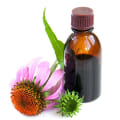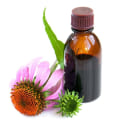Nowadays, people use echinacea to shorten the duration of the common cold and flu and reduce symptoms, such as sore throat (pharyngitis), cough, and fever. Many herbalists also recommend echinacea to help boost the immune system and assist the body in fighting infections.
Echinacea purpurea
is particularly powerful due to its high concentration of antioxidants. These antioxidants combat free radicals in the body, preventing them from reaching levels that can be detrimental to health.This is why echinacea is so beneficial for the immune system. Additionally, it can provide therapeutic benefits thanks to its polysaccharides (carbohydrates), alkamides (similar to fatty acids) and flavonoids (found in many plants). Echinacea is a herb native to North America that has been used as a traditional herbal remedy for more than 400 years by Indian tribes in the Great Plains. It is technically classified as an herb, and several species of the echinacea plant are used to make medicines from their flowers, leaves and roots. Before 1950 and the introduction of antibiotics, echinacea had an estimated medicinal status.
As the health care industry changed, antibiotics became fashionable and the famous herb lost much of its appreciation. How does echinacea help treat the common cold? A meta-analysis study conducted by the University of Connecticut and published in the journal Lancet Infectious Diseases evaluated the effects of echinacea through 14 studies. The Natural Resources Conservation Service of the United States Department of Agriculture reports that the immune system seems to be strongly influenced by the level of dose of echinacea. It appears that 10 milligrams of echinacea per kilogram of body weight, taken daily for a period of 10 days, are effective as immunity boosters. In a survey of herbal use in children with ADHD disorder or depression, echinacea was one of the most common herbal medications given to treat behavioral symptoms.
83 percent of caregivers said they only administered herbal medicines, while 13 percent administered herbal medicines with prescription drugs with the supervision of a health professional. It is recommended that people only take 20 milligrams at a time and no more. In fact, taking more than 20 milligrams per dose may nullify the anxiety-relieving benefits of echinacea. Echinacea is also a fantastic remedy for a large number of infections. A study found that taking echinacea and applying a medicinal cream to the skin can reduce the rate of recurrent vaginal infections by up to 16 percent compared to simply taking the medication alone. Some sources say that echinacea seems to be most effective when taken as soon as symptoms appear and taken many times a day for seven to 10 days.
It is also believed that liquid forms of echinacea may be more effective than capsules, which is due to their faster rate of absorption. There are nine species of echinacea, but only two of them, Echinacea purpurea and Echinacea angustifolia, are commonly used in supplements. While there is no strong evidence that echinacea has health benefits in any area, it is most commonly used to treat colds. Also called Echinacea purpurea, commonly known as pale purple echinacea, this herb is a favorite among gardeners and butterfly enthusiasts. Echinacea purpurea is the most common (and what people usually refer to when talking about this herb), while pale and echinacea angustifolia are more common in terms of morphology. Some common ways to use echinacea products to combat pain include drinking herbal echinacea tea or making a paste with dried herb and rubbing it directly onto the affected area.


